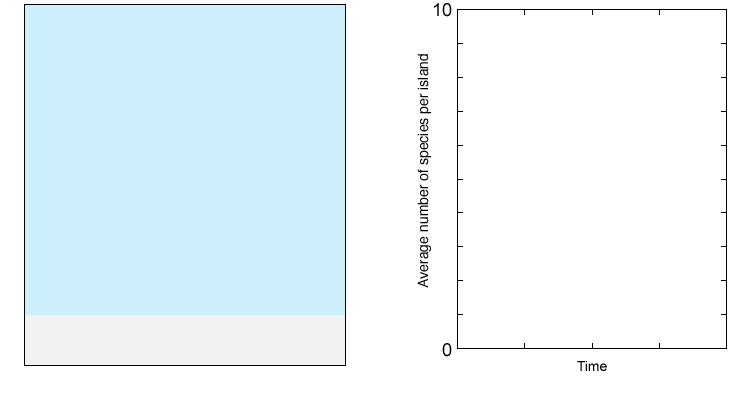INTRODUCTION
Ecologists wish to explain why communities in any given place contain the number of species that they do. In this activity, we use a simple computer model to simulate how the number of species in a community (the species richness) changes through time, and how this depends on the area of suitable habitat that is available and the distance of this habitat from some pool of colonists who can migrate to the patch of habitat. It is easiest to think of the model as a simulation of species richness on islands in an ocean, with a mainland pool of potential colonists, but this “island biogeography” framework also can apply to “islands” of habitat surrounded not by water, but by other terrestrial habitats that are unsuitable for the species we are considering.
In the model used here, the species richness of an island depends on colonization by new species from the mainland and extinction of species already present. The mainland pool consists of 10 species of birds (indicated by different colors), with 25 individuals of each species. Individual birds fly about randomly in search of food, and feed only when they are over land. They live for a fixed number of time steps without food before they die, but if they are over land and can feed, they live for additional time steps. The number of individuals in each species remains fixed—if an individual of a species dies, it is replaced by a new individual of that species in the mainland pool of potential colonists. The fact that individual birds can fly away from islands as part of their random search for food allows the model to simulate the process of extinction of species on an island.
To explore the outcome of the model, click the Simulation below. The Start/Stop button will run a simulation of the colonization of four empty islands of different sizes and distances from the mainland pool, and you will see a graph of the number of species on each island through time. (The numbers graphed are actually averages over time, representing a situation in which an ecologist is able to average across a number of replicate islands of each size and distance from the mainland.)
To move an island, click/tap to select it, then drag it to a new location. Review the plot to see the cumulative average number of species on an island over time. Click the Island Data button for a current summary.
What happens to the average number of species on islands over time? How does this change depend on the size of islands and their distance from the mainland?

To move an island, click/tap to select it, then drag it to a new location.
After running this simulation a few times you will notice that the number of species increases with island size and decreases with distance from the mainland. Let’s look at these results closely.
As the number of species on an island increases, a larger fraction of colonists will be members of species already present. Therefore, the rate of arrival of “new” species decreases, until it reaches zero when the island has all the species in the species pool.
The smaller an island population of a given species, the more likely it is to become extinct. In addition, the number of species that can become extinct increases as species accumulate on an island.
Because the rate of colonization decreases and the extinction rate increases as the number of species
increases, eventually the number of species should reach an equilibrium
( )
at which the rates of arrival and extinction are equal.
)
at which the rates of arrival and extinction are equal.

Figure 53.17 The Equilibrium Theory of Island Biogeography MacArthur and Wilson’s theory emphasized the balance between species immigration rates and species extinction rates for islands of different sizes and at different distances from a source of colonizing species.
Further, if extinction and colonization rates are relatively constant, then we expect extinction rates to be higher on small islands, because populations are smaller there. Similarly, we expect less colonization on islands more distant from the mainland.
This simulation is based on the premise that the number of species found on an island is the result of a balance between the extinction rate of existing species and the colonization rate of new species. Based on this simple premise the simulation shows that the number of species found in different areas increases with the size of the area. This species-area pattern is one of the important and highly repeatable relationships in ecological biogeography.